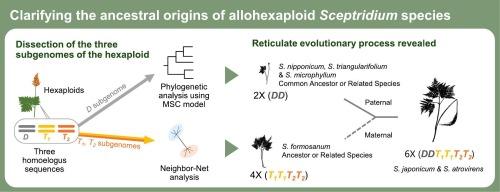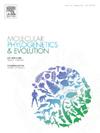Reticulate Evolution in Japanese Sceptridium (Ophioglossaceae), including diploid, tetraploid, and hexaploid species
IF 3.6
1区 生物学
Q2 BIOCHEMISTRY & MOLECULAR BIOLOGY
引用次数: 0
Abstract
Homospory represents an intriguing reproductive strategy, including the potential for gametophytic selfing, considered the ultimate form of selfing. The plants of the fern genus Sceptridium (Ophioglossaceae) are generally considered to be predominantly selfing, making them suitable for analyzing speciation patterns and intraspecific variation characteristic of homosporous plants. The Sceptridium species in Japan not only exhibit variations in ploidy, including diploids, tetraploids, and hexaploids, but also pose taxonomic challenges due to morphologically distinctive forms that are difficult to be assigned to previously described species. We developed multiple single-copy nuclear markers and aimed to identify ancestral species of the polyploids and to elucidate the evolutionary entity of an undescribed species. Chromosome counts and analyses of individual gene trees confirmed that S. japonicum, S. atrovirens, and the undescribed species are allohexaploids originating through hybridization between a maternal tetraploid ancestor closely related to S. formosanum and a paternal diploid ancestor closely related to extant diploid species. By identifying homoeologs derived from the diploid ancestor, we successfully analyzed the phylogenetic relationship between the diploid ancestor of the hexaploid species and extant diploid species using the multispecies coalescent model. The examined undescribed species could not be distinguished from S. atrovirens by multiple nuclear markers or by SNP data obtained from multiplexed ISSR genotyping by sequencing. This species appears to represent one of the polymorphisms of S. atrovirens, which was fixed through gametophytic selfing.

日本蛇尾草(Ophioglossaceae)的网状进化,包括二倍体、四倍体和六倍体物种。
同株繁殖是一种引人入胜的繁殖策略,包括配子自交的可能性,配子自交被认为是自交的最终形式。蕨类植物蛇尾蕨属(Ophioglossaceae)的植物通常被认为以自交为主,因此适合分析同孢植物特有的物种演化模式和种内变异。日本的蛇床子属(Sceptridium)物种不仅在倍性上存在差异,包括二倍体、四倍体和六倍体,而且在分类学上也存在挑战,因为它们在形态上各具特色,很难归入以前描述的物种。我们开发了多个单拷贝核标记,旨在确定多倍体的祖先物种,并阐明一个未描述物种的进化实体。染色体计数和个体基因树分析证实,日本蓟马、阿特罗维林蓟马和未被描述的物种都是异源六倍体,起源于母系四倍体祖先(与福美双密切相关)和父系二倍体祖先(与现存二倍体物种密切相关)之间的杂交。通过鉴定源自二倍体祖先的同源物,我们成功地利用多物种凝聚模型分析了六倍体物种的二倍体祖先与现存二倍体物种之间的系统发育关系。通过多个核标记或多重 ISSR 基因分型测序获得的 SNP 数据,我们无法将该未描述物种与 S. atrovirens 区分开来。该物种似乎代表了 S. atrovirens 的多态性之一,它通过配子体自交而固定下来。
本文章由计算机程序翻译,如有差异,请以英文原文为准。
求助全文
约1分钟内获得全文
求助全文
来源期刊
CiteScore
7.50
自引率
7.30%
发文量
249
审稿时长
7.5 months
期刊介绍:
Molecular Phylogenetics and Evolution is dedicated to bringing Darwin''s dream within grasp - to "have fairly true genealogical trees of each great kingdom of Nature." The journal provides a forum for molecular studies that advance our understanding of phylogeny and evolution, further the development of phylogenetically more accurate taxonomic classifications, and ultimately bring a unified classification for all the ramifying lines of life. Phylogeographic studies will be considered for publication if they offer EXCEPTIONAL theoretical or empirical advances.

 求助内容:
求助内容: 应助结果提醒方式:
应助结果提醒方式:


